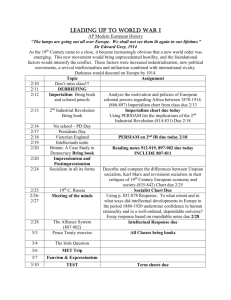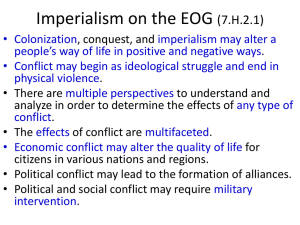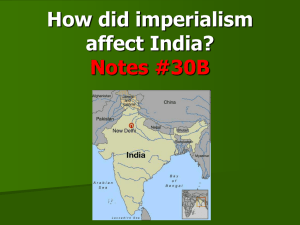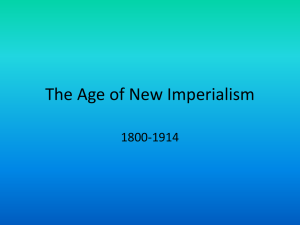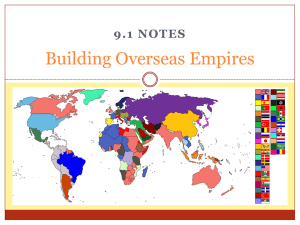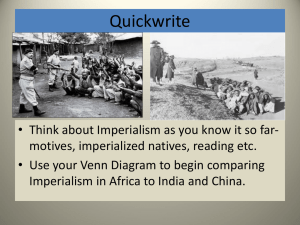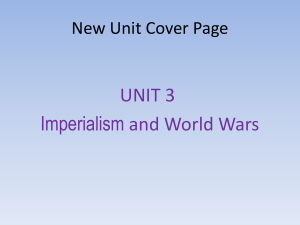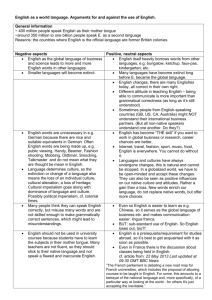28.Regents.Age.of.Imperialism.Answers
advertisement
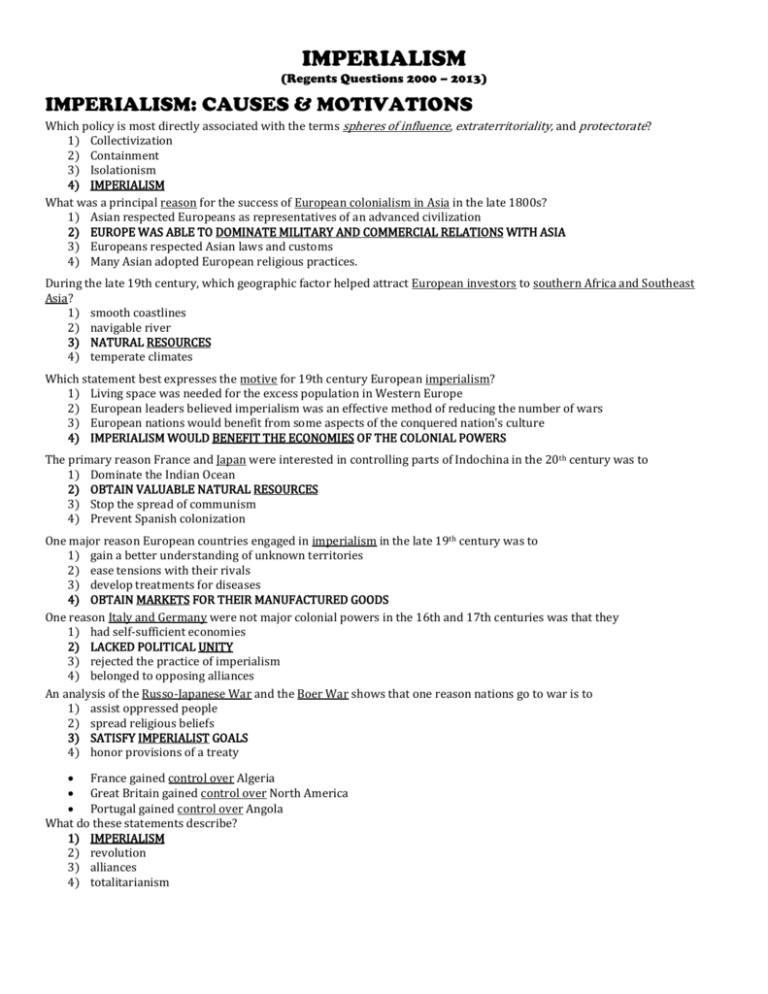
IMPERIALISM (Regents Questions 2000 – 2013) IMPERIALISM: CAUSES & MOTIVATIONS Which policy is most directly associated with the terms spheres of influence, extraterritoriality, and protectorate? 1) Collectivization 2) Containment 3) Isolationism 4) IMPERIALISM What was a principal reason for the success of European colonialism in Asia in the late 1800s? 1) Asian respected Europeans as representatives of an advanced civilization 2) EUROPE WAS ABLE TO DOMINATE MILITARY AND COMMERCIAL RELATIONS WITH ASIA 3) Europeans respected Asian laws and customs 4) Many Asian adopted European religious practices. During the late 19th century, which geographic factor helped attract European investors to southern Africa and Southeast Asia? 1) smooth coastlines 2) navigable river 3) NATURAL RESOURCES 4) temperate climates Which statement best expresses the motive for 19th century European imperialism? 1) Living space was needed for the excess population in Western Europe 2) European leaders believed imperialism was an effective method of reducing the number of wars 3) European nations would benefit from some aspects of the conquered nation's culture 4) IMPERIALISM WOULD BENEFIT THE ECONOMIES OF THE COLONIAL POWERS The primary reason France and Japan were interested in controlling parts of Indochina in the 20th century was to 1) Dominate the Indian Ocean 2) OBTAIN VALUABLE NATURAL RESOURCES 3) Stop the spread of communism 4) Prevent Spanish colonization One major reason European countries engaged in imperialism in the late 19th century was to 1) gain a better understanding of unknown territories 2) ease tensions with their rivals 3) develop treatments for diseases 4) OBTAIN MARKETS FOR THEIR MANUFACTURED GOODS One reason Italy and Germany were not major colonial powers in the 16th and 17th centuries was that they 1) had self-sufficient economies 2) LACKED POLITICAL UNITY 3) rejected the practice of imperialism 4) belonged to opposing alliances An analysis of the Russo-Japanese War and the Boer War shows that one reason nations go to war is to 1) assist oppressed people 2) spread religious beliefs 3) SATISFY IMPERIALIST GOALS 4) honor provisions of a treaty France gained control over Algeria Great Britain gained control over North America Portugal gained control over Angola What do these statements describe? 1) IMPERIALISM 2) revolution 3) alliances 4) totalitarianism “WHITE MAN’S BURDEN” & SOCIAL DARWINISM Which statement best expresses the Western perspective regarding Rudyard Kipling's "White Man's Burden"? 1) Europeans should preserve traditional cultures in Africa and Asia 2) Europeans must protect existing African and Asian economies 3) Europeans suffered great hardships in exploring new trade routes to Asia 4) EUROPEANS HAD A DUTY TO INTRODUCE THE BENEFITS OF THEIR CIVILIZATION TO NON-EUROPEAN PEOPLES Which statement would Social Darwinists most likely support? 1) Universal suffrage is a basic human right 2) Political equality strengthens the effectiveness of government 3) STRONGER GROUPS HAVE THE RIGHT TO RULE AND CONTROL WEAKER GROUPS 4) Public education should be guaranteed to all members of society The theory of Social Darwinism was sometimes used to justify 1) the establishment of communist governments 2) Latin American revolutions in the early 19th Century 3) the independence movement in India 4) EUROPEAN IMPERIALISM IN THE LATE 19TH CENTURY The 19th century ideas of Social Darwinism and the “White Man’s Burden” were often used to justify 1) Isolationism 2) Appeasement 3) IMPERIALISM 4) Disarmament The message of this poem was used by many Europeans to justify 1) industrialism 2) feudalism 3) IMPERIALISM 4) fascism This stanza from Kipling's poem is most closely associated with the belief that it was the duty of Western colonial powers to 1) learn from the people they conquered 2) teach their colonies how to produce manufactured goods 3) CIVILIZE THE PEOPLE THEY CONTROLLED 4) welcome less developed countries as equals The words of this poem have been used to support the practice of 1) IMPERIALISM 2) isolationism 3) cultural borrowing 4) self-determination IMPERIALISM IN ASIA Treaty of Nanjing gives control of Hong Kong French government sets up a protectorate in Cambodia Italian forces occupy Ethiopia Which policy is most closely associated with these statements? 1) Détente 2) Appeasement 3) Nonalignment 4) IMPERIALISM The idea expressed in this cartoon is most closely associated with the 1) Alliance formed in Europe 2) Division of Africa discussed at the Berlin Conference 3) SPHERES OF INFLUENCE ESTABLISHED IN CHINA BY FOREIGNERS 4) Border changes made at the Congress of Vienna Which phrase correctly completes this diagram? 1) Chinese exports of tea to Europe 2) Spread of Confucian principles 3) FAILURE OF THE BOXER REBELLION 4) Expanding power of Mao Zedong During the 19th century, European nations established spheres of influence in China mainly to 1) Profit from the ivory trade 2) Introduce Islam to the Chinese people 3) Gain commercial advantages in China 4) Obtain human rights for Chinese citizens One result of the Opium War was that China 1) adopted democratic reforms 2) gained control of Hong Kong 3) regained control of Manchuria 4) WAS DIVIDED INTO SPHERES OF INFLUENCE The terms sphere of influence, extraterritoriality, and mandates are most closely associated with 1) Collective security 2) Militarism 3) IMPERIALISM 4) Self-sufficiency The British government took control of the Suez Canal and Singapore during the 19th century in order to 1) Sell petroleum to these territories 2) Gain more converts to Christianity 3) ENSURE SAFE PASSAGE ON STRATEGIC WATERWAYS 4) Transport laborers directly to the Americas The Opium Wars in China and the expedition of Commodore Matthew Perry to Japan resulted in 1) The economic isolation of China and Japan 2) An increase in Chinese influence in Asia 3) The beginning of democratic governments in China and Japan 4) AN INCREASE IN WESTERN TRADE AND INFLUENCE IN ASIA The Opium Wars of the mid-19th century marked the beginning of the 1) Rivalry between China and Taiwan 2) DOMINATION OF CHINA BY FOREIGN POWERS 3) Decline of European influence in East Asia 4) Global effort to combat drug use Which conclusion can be drawn from this passage? 1) China can no longer remain isolated from its neighbors 2) The Chinese people are happy with the rule of the Manchu 3) THE CHINESE PEOPLE WANTED TO END FOREIGN OCCUPATION 4) China has prospered under the rule of foreign powers. What is the primary focus on this map? 1) Population density 2) Resource distribution 3) IMPERIALISM 4) Urbanization IMPERIALISM IN AFRICA The Berlin Conference in 1884 was significant because it 1) Promoted Belgium as a world power 2) ESTABLISHED RULES FOR THE EUROPEAN DIVISION OF AFRICA 3) Called for a war against England 4) Ensured ethnic harmony in the Middle East Which statement best reflects an effect of imperialism in Africa? 1) Land was distributed equally between social classes. 2) Territorial divisions were primarily established using tribal boundaries 3) NATURAL RESOURCES WERE EXPLOITED FOR THE BENEFIT OF EUROPEAN POWERS 4) Timbuktu became the center of great learning Which of these developments in Africa was a cause of the other three? 1) Rival tribal groups fought wars. 2) THE BERLIN CONFERENCE OF 1884 INFLUENCED COLONIAL BOUNDARIES 3) Traditional territories and culture groups were permanently fragmented 4) African economies became dependent on the sale of cash crops and raw materials Which situation was a result of the 1884 Berlin Conference? 1) AFRICA WAS DIVIDED WITHOUT REGARD TO ETHNIC GROUPS 2) Monarchies were restored throughout Europe 3) The slave trade with South America was eliminated 4) The League of Nations was formed. Which area of the world was most directly affected by the decisions made at the Berlin Conference? 1) AFRICA 2) China 3) India 4) South America What was a major reason European nations competed for control of Africa during the second half of the 1800s? 1) AFRICA HAD A WEALTH OF NATURAL RESOURCES 2) Slave labor was needed in the Americas 3) African nations offered religious and political freedom 4) Europeans needed land for their excess population Much of which area of the world came under European colonial control in the 19th century? 1) Japan 2) Southwest Asia 3) AFRICA 4) Latin America Which slogan best reflects the point of view of Cecil Rhodes in this cartoon? 1) “IMPERIALISM IS A GLORIOUS PURSUIT” 2) “Embrace African Diversity” 3) “Unite All Africans” 4) “Connecting Constantinople to Cairo” One of the most important motives for the European "Scramble for Africa" in the late 1800s was that Africa provided a source of 1) RAW MATERIALS USED IN INDUSTRY 2) religious inspiration 3) free labor for the Americas 4) technologically innovative practices After World War II, the boundaries of newly independent African countries were most often based on 1) Existing ethnic settlement patterns 2) DIVISIONS IMPOSED UNDER EUROPEAN IMPERIALISM 3) Mandates created under the United Nations 4) Locations of oil resources Many of the political divisions shown on this map were directly related to the 1) Meiji Restoration 2) Opium Wars 3) BERLIN CONFERENCE 4) Boer War According to the information provided by the map, which European nation controlled the Union of South Africa? 1) Germany 2) France 3) GREAT BRITAIN 4) Italy The best title for this map would be 1) EUROPEAN IMPERIALISM 2) African Nationalism 3) The Growth of Islam 4) Cold War Politics Which region was most affected by decisions made at the Berlin Conference of 1884? 1) Latin America 2) South Asia 3) East Asia 4) AFRICA The borders that were established for many African nations during the late 1800s were based primarily on 1) natural geographic barriers 2) easy access to natural resources 3) TERRITORIAL CLAIMS OF COLONIAL RULERS 4) cultural differences between ethnic groups SEPOYS & BOXERS The Sepoy Rebellion is considered an important event in Indian history because it was one cause of the 1) INDEPENDENCE MOVEMENT IN INDIA 2) Secession of Bangladesh from Pakistan 3) Establishment of French colonies in India 4) Creation of the Mughal Empire by Muslims A goal of both the Boxer Rebellion in China and the Mau Mau movement in Kenya was to 1) Promote laissez-faire capitalism 2) END FOREIGN CONTROL 3) Develop modern industries 4) Create a totalitarian state One similarity between the Sepoy Mutiny and the Boxer Rebellion is that they 1) OPPOSED EUROPEAN IMPERIALISM 2) Ended an established dynasty 3) Resulted in the redistribution of land 4) Instituted communist governments The Sepoy Rebellion was to India as the Boxer Rebellion was to 1) Russia 2) CHINA 3) Japan 4) Italy A major goal of both the Sepoy Mutiny and the Boxer Rebellion was to 1) REMOVE FOREIGN INFLUENCES 2) Restore parliamentary government 3) Improve access to civil service examinations 4) Outlaw caste systems A major goal of both the Sepoy Mutiny in India and the Boxer Rebellion in China was to 1) RID THEIR COUNTRIES OF FOREIGNERS 2) expand their respective territories 3) receive international military support 4) restore an absolute monarch to the throne One similarity between the Sepoy Rebellion in India and the Boxer Rebellion in China is that both were 1) Religious reform movements 2) Reactions to the opium trade 3) ATTEMPTS TO END FOREIGN INTERFERENCE 4) Successful revolts against absolute monarchs One way in which the Sepoy Rebellion in India and the Boxer Rebellion in China are similar is that both attempted to 1) REMOVE FOREIGN INFLUENCES 2) Restore democracy 3) Modernize their economy 4) End religious conflict A similarity between the Sepoy Rebellion in India and the Boxer Rebellion in China is that both were 1) ATTEMPTS TO REMOVE FOREIGN INFLUENCE 2) Movements to establish communist governments 3) Efforts to restore trade monopolies 4) Struggles to westernize cultures Opium War (1839 – 1842) Taiping Rebellion (1850 – 1864) Boxer Rebellion (1898 – 1901) This series of events is mostly closely associated with the 1) Spread of communism to China and Korea 2) GROWING CONCERNS ABOUT THE INFLUENCE OF THE WEST IN CHINA 3) Alliance formed between Vietnam and China 4) Increasing expansion of civil and political rights in China One way in which the Sepoy Mutiny in India, the Zulu resistance in southern Africa, and the Boxer Rebellion in China are similar is that each resulted from 1) Government policies of ethnic cleansing 2) Attempts by democratic forces to overthrow the monarchy 3) NATIVE REACTION TO FOREIGN INTERFERENCE IN THE REGION 4) Government denial of access to fertile farmland Which was an example of Asian reaction to European imperialism? 1) BOXER REBELLION 2) Glorious Revolution 3) Boer War 4) Congress of Berlin Which historical development showed the desire of a group to gain independence from a colonial power 1) rise of the Nazi party in Germany 2) Solidarity movement in Poland 3) Tiananmen Square uprising in China 4) SEPOY MUTINY IN INDIA RESULTS & CONSEQUENCES To which period does the slogan "The Sun never sets on the British Empire" refer? 1) Middle Ages 2) Protestant Reformation 3) AGE OF IMPERIALISM 4) Glorious Revolution The establishment of parliamentary democracy in India and the establishment of Portuguese as the official language of Brazil indicates that European colonizers 1) INFLUENCED THE CULTURE OF REGIONS UNDER THEIR CONTROL 2) Respected the governments of the indigenous peoples 3) Promoted Protestant religions over native religions 4) Studied local traditions before implementing policies This Thomas Nast cartoon shows the 1) COMPETITION BETWEEN EUROPEAN NATIONS FOR OVERSEAS TERRITORIES AFTER THE BERLIN CONFERENCE 2) aggressive action of the Triple Alliance before WWI 3) concern of European nations for the welfare of developing nations at the end of the 19th Century 4) spread of communism throughout the world during the 19th Century Some developing countries rely on a single cash crop such as cotton or sugar cane. The origin of this practice can often be traced to the 1) Introduction of communism 2) Establishment of democratic governments 3) COLONIZATION OF THE REGION 4) Movements to gain independence ANTI-COLONIALISM & INDEPENDENCE Mahatma Gandhi and Jomo Kenyatta were similar in that both 1) supported colonial policies 2) SOUGHT TO GAIN INDEPENDENCE FROM GREAT BRITAIN 3) led a worldwide boycott of British goods 4) used violent revolution to achieve their aims One similarity in the actions of Ho Chi Minh and Jomo Kenyatta was that both leaders 1) introduced Western ideas to their societies 2) established democratic forms of government 3) LED NATIONALIST MOVEMENTS 4) supported separation of church and state As leader of the Mau Mau in the 1950s, Jomo Kenyatta promoted these ideas as a way to 1) WORK FOR KENYA' S INDEPENDENCE 2) imitate the practices of Mohandas Gandhi 3) develop closer ties with England 4) attract foreign investment to his nation Which idea is reflected in this passage? 1) imperialism 2) NATIONALISM 3) totalitarianism 4) neocolonialism The political ideas of Ho Chi Minh, Fidel Castro, and Pol Pot were strongly influenced by the writings of 1) Confucius 2) Mohandas Gandhi 3) Desmond Tutu 4) KARL MARX The Boxer Rebellion, the Salt March, and the Iranian Revolution were reactions against 1) Mongol Rule 2) rapid industrialization 3) WESTERN INFLUENCE 4) economic depression One way in which Chiang Kai-shek (Jiang Jieshi) of China, Ho Chi Minh of Vietnam, and Jomo Kenyatta of Kenya were similar is that they all 1) supported close ties with their former colonial powers 2) opposed United Nations membership for their governments 3) LED NATIONALISTIC MOVEMENTS IN THEIR NATION 4) resisted attempts to modernize their nation's political and social institutions A factor that contributed to the success of both Ho Chi Minh in Vietnam and Mao Zedong in China was their ability to combine 1) imperialism and traditionalism 2) NATIONALISM AND COMMUNISM 3) ethnocentrism and democracy 4) isolationism and capitalism One way in which Simon Bolivar, Camillo di Cavour, and Ho Chi Minh were similar is that they 1) ENCOURAGED A SPIRIT OF NATIONALISM AMONG THEIR PEOPLE 2) enlisted the support of European nations to achieve their goals 3) opposed territorial expansion of their nations 4) followed the ideas of Thomas Hobbes in establishing systems of government One way in which Toussaint L’Ouverture, Kwame Nkrumah, and Ho Chi Minh are similar is that each leader 1) Opposed the role of eh Roman Catholic Church in politics 2) Established the first democratic government in his country 3) FOUGHT TO FREE HIS COUNTRY FROM EUROPEAN CONTROL 4) Embraced the principles of civil disobedience In the struggle to gain independence for their countries, both Kwame Nkrumah and Ho Chi Minh relied on 1) NATIONALIST SENTIMENTS 2) Trench Warfare 3) Collective Security Agreements 4) Nonviolent resistance One way in which Jose de San Martin, Camillo Cavour, and Jomo Kenyatta are similar is that each leader 1) Made significant scientific discoveries 2) LED NATIONALIST MOVEMENTS 3) Fought against British imperialism 4) Became a communist revolutionary
